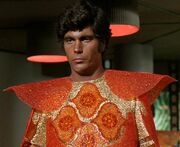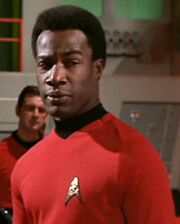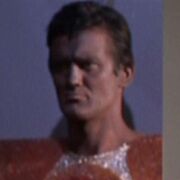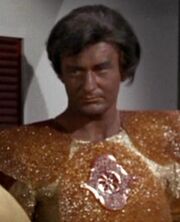A British colonel under the Raj fell captive to mountain tribes. When he tried to escape, he fell down a mountain ravine and was crippled for life. Villagers carried him to their hut, where they fed him scraps and kept him alive in a basket.
Author Archives: Tom Crippen
Kennedy’s lasting achievement
Wiki Trek: “Elaan of Troyius”
Some production facts from Mem Alpha, just because they interest me:
… Similarly to “The Corbomite Maneuver“, this episode was filmed early in the season, but aired much later because of the many, newly created special effect shots which took lot of time to be filmed and added in post-production.
… more costume changes than any other TOS character with the exception of Barbara Anderson (Lenore Karidian) in “The Conscience of the King.” Guest star France Nuyen’s costumes are far more revealing, however: the purple halter top, the silver flowered thing on black mesh, the orange dress, and the blue wedding gown with no sides.
This episode marks the first appearance of the Matt Jefferies-designed Klingon ship ... The new emblem of the Klingon Empire is seen on the model …
War vessel. Like people say, Matt Jefferies did great work. He designed the Enterprise and the bridge, both of which are magnificent, then followed himself with the Klingons’ war ship, also a triumph. The ship is oddly beautiful: kind of scary and off looking, like an alien warship should be, but in subtle ways, and at the same time it draws the eye: the ship is uncomfortable to look at but also pleasing to look at. I think it outclasses everything else about the old-series Klingons: the make-up, the dumb names (“Klingon” itself is kind of dumb). In fact I’d say it was better than the show’s Vulcan stuff, even better than Mr. Spock’s ears. The Klingon ship is old Star Trek‘s best go at representing alienness, a pretty fundamental mission for the series.
Shatner’s enemy. MemAlpha mentioned France Nuyen‘s outfits. She was born 1939, Marseilles; original name: France-Nguyen Van-Nga. The wig is copied off the cover painting of a science fiction magazine from a good ways back.
Per Wiki, Nuyen’s father was Vietnamese, mother was a French gypsy. When she was a teen somebody photographed her on the beach and she became a starlet.
In 1958 Nuyen and Bill Shatner starred in the Broadway adaptation of a hit novel, The World of Suzie Wong. Shatner says the play was sold out for months in advance because of mass theater parties booked from out of town. He claims that the result was a disaster because Nuyen was incompetent and impossible, a temperamental brat, somebody who couldn’t be trusted even to deliver her lines or do what the stage directions said.
The play would just fall apart, night after night, and Shatner had to stay alive up there somehow. So he began bending his lines; he twisted their delivery, sent the emphasis where it wasn’t expected. That way he could give the audience something to pay attention to. This is the origin story for the famous Shatner delivery, the crosswire rat-a-tat-tat everyone parodies. (“Man … was meant … to try,” and on “to” his voice goes up, and on “try” it goes down, throws the word away.) He learned those tricks so he could survive France Nuyen. Sources: Up Till Now and Neal Pollack’s comments during Shatner’s Comedy Central roast, though I don’t advise watching the roast unless you’re some kind of moron. ( update, Not Neal Pollack. It was Kevin Pollak. )
Ambassador, others. The green ambassador (Petri), b. 1930, NYC. Wiki says he did a lot of “summer stock and repertory companies,” then Shakespeare on Broadway, first movie was The Robe (1953), played Caligula.
Black redshirt. He has a couple of lines, pops up in a couple of scenes, though he doesn’t get to do anything useful. Was also Greg Morris’s stunt double on Mission: Impossible.
He was the guy in the Swamp Thing costume in Swamp Thing, The Return of Swamp Thing, and the Swamp Thing tv series. Mem Apha mentions movie credits in ’70s, ’80s, ’90s, in most cases decently budgeted films.
Only known appearance: The other alien bodyguard, another soul killed by Star Trek‘s wig deptartment:
Strange encounter
Easy laugh
I told Griffy, my building’s janitor, that traditional Chinese medicine abhors masturbation on the grounds that the practice drains yang without an influx of yin (I think).
You talking about Chappaquidick, son?
He would be a very fortunate man if his heroic last few months were what future generations remember him most for.
Pauline Kael and Charles Murray
She’s the stooge for a rhetorical gimmick that is one of the right’s second-level favorites. Charles Murray hauled the gimmick out during a recent discussion when he referred to “Pauline Kael Syndrome.” The idea is that she was the movie critic for The New Yorker, so therefore in 1972 (the year of Nixon’s great landslide) she must have said the following:
“How can Nixon have won? No one I knew voted for him”
“I live in a rather special world. I only know one person who voted for Nixon. Where they are I don’t know. They’re outside my ken. But sometimes when I’m in a theater I can feel them.”










